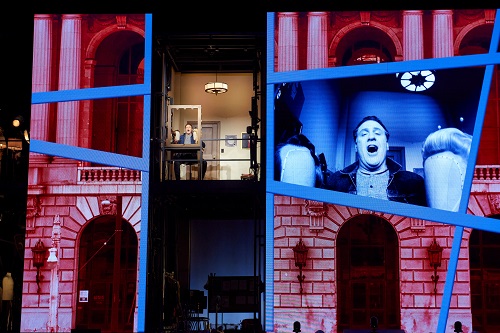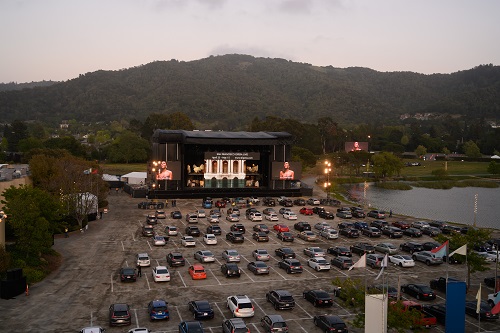 United States Rossini, The Barber of Seville: Soloists and Orchestra of San Francisco Opera / Roderick Cox (conductor). Marin County Civic Center, San Rafael, California, 23.4.2021. (HS)
United States Rossini, The Barber of Seville: Soloists and Orchestra of San Francisco Opera / Roderick Cox (conductor). Marin County Civic Center, San Rafael, California, 23.4.2021. (HS)

from his War Memorial Opera House ‘dressing room’ (c) Stefan Cohen/SFO
Production:
Director – Matthew Ozawa
Sets and projection – Alexander V. Nichols
Costumes – Jessica Jahn
Lighting – JAX Messenger
Cast:
Figaro – Lucas Meachem
Rosina – Daniela Mack
Count Almaviva – Alek Shrader
Doctor Bartolo – Philip Skinner
Don Basilio – Kenneth Kellogg
Berta – Catherine Cook
San Francisco Opera returned to the stage for the first time since 2019 with an innovative, truncated, yet surprisingly enjoyable production of Rossini’s The Barber of Seville. It was the company’s first try in front of a live audience since the pandemic shut things down before the 2020 spring performances could happen. Everything has been virtual, and much of it outstanding.
Opening night’s ‘crowd’ gathered in the parking lot of the Marin County Civic Center (about a half-hour’s drive from the War Memorial Opera House), a picturesque setting next to a lagoon. They watched from their cars as the proceedings unfolded on a purpose-built stage. The setup allows for 200 cars plus another 200 in a separate area across the lagoon with a jumbo TV screen.

(c) Stefan Cohen/SFO
Per COVID-19 safety protocols, the cast stayed six feet apart (mostly), and the orchestra spaced itself out inside a tent behind the stage. The music reached the audience’s ears via FM radios in their cars. Running time was to be trimmed to 100 minutes with no intermission. Everything was cut except arias and ensembles, and the concision also did away with several secondary roles and the chorus.
Stage director Ozawa wrote in the digital program: ‘In taking out some of the links of the story and then looking at what music remained, it became apparent to me that I needed to . . . rearrange the musical numbers and thread it together in a completely new way’.
The new storyline plays on the reality that we were all coming back for live opera for the first time in more than a year. Ozawa was to have directed his own new production of Beethoven’s Fidelio before last fall’s season opener was canceled, and he found a way to repurpose a structure built for the Fidelio set into a facsimile of the War Memorial Opera House. The ‘curtain’ (actually a set of four tall TV screens that slide back and forth to reveal the set behind them) was the façade, complete with the green fencing that has separated it from ongoing road work along Van Ness Avenue. As the screens roll right and left, they reveal sections of the opera house’s interior: dressing rooms on the top level, rehearsal spaces below.
During the overture, jumbo TV screens to the right and left of the stage showed a witty black-and-white video of cast members making their way to their dressing rooms in the building that’s closed to the public. One by one, the singers ‘practice’ their signature arias in these dressing rooms. Duets and ensembles happen later in the rehearsal space. To tie it all together, announcements from an unseen stage manager (voiced by Jennifer Good, in real life the company’s managing director of production) announces alerts the cast would actually hear backstage.
This provides plenty of opportunity for gags, a key part of any Barber production. Some lampoon the singers’ warmup tics and nervous references to their open scores, while others play off the requirement to wear masks and keep six feet away from each other.
The cast sings entirely in English. The translation by Marcie Stapp (a coach on the faculty of the San Francisco Conservatory, editor of the Nico Castel opera translation volumes and creator of a stack of original opera translations) rides deftly on Rossini’s rhythms and somehow remains true to the original libretto’s colloquial style.
The rewritten plot also reshuffled the order, especially at the beginning. Baritone Lucas Meachem kicked things off with a smoothly sung and personality-infused run-through of Figaro’s boastful aria, ‘Bow to the master’ (Largo al factotum), followed by tenor Alek Shrader’s polished, sweet ‘See now the dawn’s bright welcome’ (Ecco ridente in cielo), the count’s serenade. Meanwhile mezzo-soprano Daniela Mack, as Rosina, the target of Lindoro’s wooing, can be seen thumbing through a copy of Elle in her room. She then followed with ‘Title’ (Una voce poco fa), her lush, agile range reaching high and low without strain.
Everyone articulated the English so well that texts projected above the stage were almost unnecessary. None was more impressive than bass Kenneth Kellogg in the rapid-fire patter of Don Basilio’s ‘La calunnia’ (which begins with the Italian word for slander, but goes on in English).
After the Figaro-Almaviva and Rosina-Figaro duets engage in some staged fun with social distancing – a three-foot-long gripper plays a role – the rehearsal continues with the Act I finale, in which the count pretends to be a drunken soldier, and Rosina and Figaro play out their letter tricks. Baritone Will Barton, a member of the company’s chorus, stands in for a whole male chorus of cops with a few key lines and, when the count reveals his identity, the entire cast executes with precision the ‘stupefied’ ensemble that follows.
On lunch break, the diva overhears mezzo-soprano Catherine Cook, consigned to a basement dressing room, rehearsing Berta’s ‘He’s just itching to get married’ (Il vecchiotto cerca moglie) with verve honed from decades of delivering winning character roles. Bass Philip Skinner, as Bartolo, practices ‘Could a man of my perception’ (A un dottor’ del mia sorte), his one aria moment.
The final scene gets us at last to the opera house stage, with some great background video focused on details of the War Memorial and a refreshingly unforced trio by the three leads. A rousing finale by the entire cast has the effect of celebrating a return to live performance.
Most of the cast would be familiar to San Francisco Opera fans. Meachem and Mack sang these roles in 2013 and 2015, the last two times Rossini’s opera was mounted, and Shrader in 2013. Shrader and Mack are married: lucky for her that this rewrite makes her notable pregnancy moot. Skinner and Cooke have sung dozens of roles with the company.
If conductor Roderick Cox, making his company debut, favored tempos a bit deliberate to convey the liveliness of Rossini’s music, the 18-piece orchestra provided capable work with nary a slip, despite being stationed in a separate tent.
Alexander V. Nichols, set designer for the San Francisco-based Margaret Jenkins Dance Company, created sets and projections that were so busy they reminded me of arena rock concerts. (The stage setup, in fact, is patterned after the one used at Coachella.) There was certainly plenty of eye appeal, and the audience lapped it up.
As the cast took their final bows, the audience responded with persistent honking and waving of glow sticks (which had been provided to all attendees). And why not? An actual live performance, a good one, surely had energized them.
Live performances continue through 15 May. The company promises a digital at-home stream of the production for purchase later this spring.
Harvey Steiman
For more about San Francisco Opera click here.